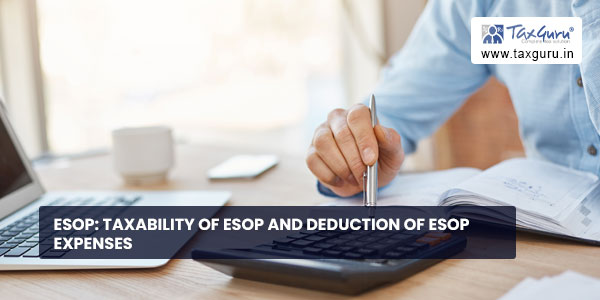ESOP stands for Employee Stock Option Plan. Under ESOP, the employer offers shares of the company to the employees under the manner in which the option will be implemented and exercised. ESOPs can be offered for various reasons to employees such as incentives, in exchange for know-how or as an option to pay low salaries with an offer to exercise ESOP.
Employee Stock Option Plan gives the employees a share of ownership interest in the company which aligns the goals and objectives of employees and shareholders. ESOP compulsorily attracts a minimum vesting period of 1 year by employees and the lock-in period depends upon the choice of employer.
Taxability of ESOP in the hands of the Employee
Initially, ESOPs were covered under Fringe Benefit Tax. Later on, in the fiscal year 2010-11, Fringe Benefit Tax was abolished. Now, the taxability lies in the hands of the option holder i.e. employees.
ESOP can be taxable in the hand of employees at two different stages:
1. At the time of Exercise of Option by the Employees
To calculate tax on ESOP, firstly we need to ascertain the perquisite. The perquisite is the difference between the Fair Market Value (FMV) of the shares allotted and the exercise price of the shares under ESOP. Perquisite shall be deducted in the same manner as the deduction of tax on salary (TDS on Salary).
How do we calculate perquisite?
As per Rule 3(8) of the Income Tax Rules, 1962:
- In a case where, on the date of the exercising of the option, the share in the company is listed on a recognized stock exchange, the fair market value shall be the average of the opening price and closing price of the share on that date on the said stock exchange.
- Provided that where, on the date of exercising of the option, the share is listed on more than one recognized stock exchange, the fair market value shall be the average of opening price and closing price of the share on the recognised stock exchange which records the highest volume of trading in the share.
- In a case where, on the date of exercising of the option, the share in the company is not listed on a recognised stock exchange, the fair market value shall be such value of the share in the company as determined by a merchant banker on the specified date.
2. At the time of the sale of shares by the Employees
While exercising the option, the employee has two choices of either holding the shares or selling them off. If the employee prefers the later choice, he/she will realize the profit which will be taxable under Capital Gain tax.
Profit for the capital gain tax is the difference between sale consideration and the fair market value of the share as on the date of the sale of shares. The next question arises whether the gain will be LTCG or STCG? To ascertain LTCG or STCG, the holding is to be considered from the date of allotment of shares.
In the case of the shares of a Listed Company:
- Where the shares are held for a period less than or equal to 12 months, the profit from the sale of such shares is short term capital gain. Therefore, as per the provisions of Section 111A of the Income Tax Act, 1961, thus the profit will be taxed at a rate of 15%.
- Where the shares are held for a period exceeding 12 months, the profit from the sale of such shares is long term capital gain. Section 112A was introduced in the IT Act and was made applicable from April 1, 2018. This section imposes an LTCG tax at the rate of 10% without indexation where the gains are in excess of Rs. 1 lakh.
In the case of the shares of an Unlisted Company
- Where the shares are held for a period less than or equal to 24 months, the profit from the sale of such shares is short term capital gain. The tax on this STCG will be treated as similar to that of any other income, and the regular income tax slab rates as applicable to the employee shall be applied here.
- Where the shares are held for a period exceeding 24 months, the profit from the sale of such shares is long term capital gain. The tax on this LTCG is chargeable as per Section 112 of the Income Tax Act, at the rate of 20% with indexation benefits.

Deductions in the hands of the Employer
Discount on the issue of ESOP is a general expense in the hands of the employer. Due to its general nature, Discount on the issue of ESOP is neither personal nor capital expenditure. Thus, the question has always been whether it should be considered as a general provision under Section 37 of the Income Tax Act, 1961?
Hence there have been multiple judgements ruled in the favour of the employer citing allowance of the expenses of discount on the issue as a deduction under section 37(1) of the Income Tax Act on the satisfaction of the following conditions:
1. The expense does not fall in the category of expenditure as stated in sections 30 to 36;
2. Expense should neither be capital expenditure nor personal expenditure.
3. Expense should be incurred wholly for the purpose of business or profession.
Reference: CIT vs Lemon Tree Hotels Limited and M/s Biocon Limited versus Deputy Commissioner of Income Tax, Bengaluru.





“Profit for the capital gain tax is the difference between sale consideration and the fair market value of the share as on the date of the sale of shares.”
This is strange as normally a Capital gain would be higher of Sale Consideration or FMV on date of sale LESS the cost at time of excercising the option even if the FMV may have been higher on that date.